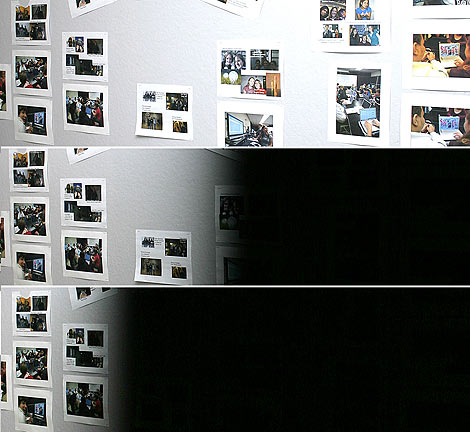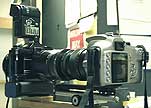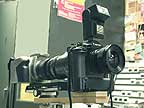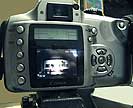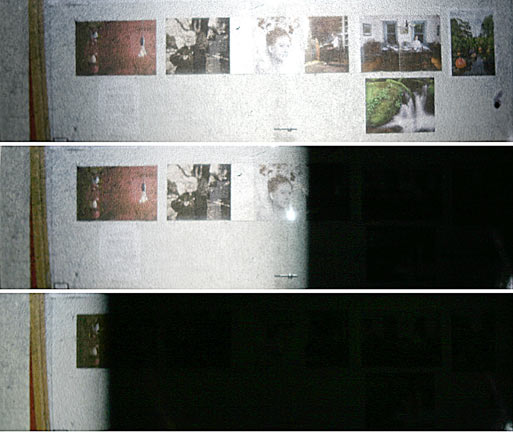|
Checking the exposure effect when an electronic flash is used at the incorrect shutter speed - the easy and hard way of doing it Andrew Davidhazy Imaging and Photographic technology School of Photographic Arts and Sciences Rochester Institute of Technology I was asked the other day to produce a set of photographs that illustrated the performance of a focal plane shutter when it is used with an electronic flash at times shorter than the minimum allowed shutter speed to record a fully illuminated photograph. Electronic flashes are designed to be operated at times at or longer than what is called the X synch speed of the shutter built into the camera. Typically these times are something of the order of 1/60 to 1/200 or so second depending on the camera. 1/60th is common with horizontally traveling shutters built into many film type 35 mm cameras. If the shutter moves vertically then these times drop to 1/90 or somewhat less in certain cameras. In digital cameras with smaller sensor areas than film and faster shutter curtains the minimum exposure times allowed are even shorter and range from 1/125 or maybe 1/400 second. These cameras typically also are equipped with vertically traveling shutter curtains. In any case, if these cameras are used at exposure times less then the "X" sync speed the distance between the leading and trailing curtains of the shutter is smaller than the film frame or electronic sensor in digital cameras leading to an exposure that reflects a record of only a partial area of the scene illuminated by the flash. Some automatic cameras do not allow such errors to be made but if they did the result would be the same. A partial exposure of the frame. The degree to which the shutter cuts into an image is a function of the degree to which the shutter speed used is less than the "X" sync speed of the camera. As rule of thumb on can deduce that if the exposure time used is 1/2 the X sync speed then the frame will be only half exposed and if 1/4 then the recorded area will be only 1/4th the full frame. At first I approached the problem of visualizing this effect by using my Canon Digital Rebel camera. It has a X-sync speed of 1/200 second. Although the camera has a built-in flash it can not be used at an incorrect shutter speed so I opted to have the camera fire an external flash I attached to the hot shoe of the camera. I decided to turn the camera in a vertical direction and this would show the "effect" in a horizontal direction. Setting the camera on MANUAL exposure I lit up a scene with the flash using the camera at 1/200, 1/500 and 1/1000 second. As you can see from the result the shutter curtain impinged within the area of the scene essentially as stated above. The top strip was exposed at 1/200 second, the middle at 1/500 and the bottom one at 1/1000 second. The 2nd shutter curtain progressively impinges more and more into the frame. Next I decided to show the "action" in a 35 mm film type camera but without using film as the recording medium. To do this I installed a ground glass surfaced field lens at the focal plane of the 35 mm camera. The filed lens is really nothing more than a slight positive lens element or "magnifying glass". If only a piece of ground glass is used then the image formed on it suffers from light fall-off towards the edges. The field lens brings the rays falling on the edges of the image area towards the center where either our eyes can pick them up or a camera lens focused on the ground glass can also pick them up. The use of such an optical element simply makes for more evenly illuminated images. They are incorporated into all SLR viewing systems. Then the plan was to use a macro lens at as close a distance to the focal plane of the film camera as possible so the 35 mm frame would almost fill the frame of a digital camera coupled to the macro lens. 1:1 imaging was not possible because the frame of the 35 mm camera is bigger than that of the digital camera but with the macro lens set-up to 1/2 life size reproduction the frame of the 35 almost filled the frame of the digital camera. This would ensure the highest possible degree of image quality in the digital record. Few pixels would have to be "thrown away"! The rig I built to accomplish this task is shown below: The digital camera was attached to a moveable platform to allow me to easily focus the lens set to its maximum magnification (1:2) or 1/2 life size at the proper distance from the ground glass/field lens combination installed in the back of the 35 mm camera from which the back had been unsnapped and removed. It was important to achieve the highest quality to install as much baffling as possible between the macro lens and the back ot the 35 camera because the Canon would be used at brief exposure times during which the 35 mm camera would be making "exposures" by firing a flash at X sync speed. 1/2 x sync speed and 1/4 sync speed. Namely 1/60 second. 1/125 second and 1/250 second. The digital camera, on the other hand, simply needed to keep its shutter open on "b" awaiting the appearance of the image on the groundless of the 35 mm camera when its shutter was fired which in turn fired the electronic flash connected to it. As you can see from the record below the effect is the same as with the digital camera. When the exposure is shorter than the minimum allowed the frame only records a partial image of the scene in front of the camera because by the time the flash fires the trailing curtain has already covered up part of the 35 mm cameras' image gate. The top strip was made with the 35 mm camera's shutter set to 1/60 second and this resulted in a full frame exposure. The middle frame at 1/125 second an it illustrates the fact that by the time the flash went off the 2nd curtain had already covered up a significant portion of the frame. When the shutter is used at 1/250 second even lore of the frame is covered up. Finally I decided to use the film camera as was intended and made some exposures using film as the recording medium and duplicated the tests made with the macro lens photographing the image formed on a ground glass by the 35 mm camera's lens. I am waiting for the results from the lab!! I expect the results to be similar to the images shown above!! If you have any questions about the
material above or if you found it useful drop me a line at:
andpph@rit.edu
|
